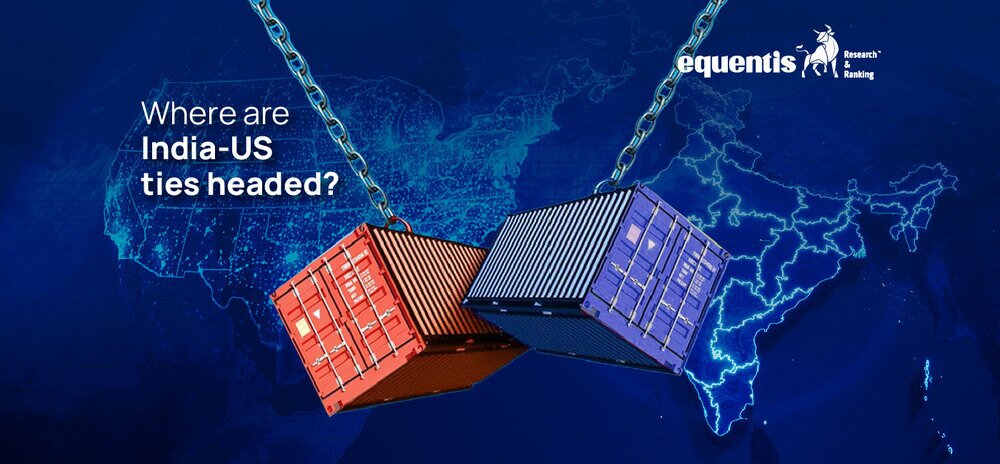The trade relationship between India and the United States has long been a cornerstone of both nations’ economic strategies. Over the decades, this partnership has evolved, reflecting shifts in global economic power, policy changes, and mutual interests. Today, as President Donald Trump amplifies his rhetoric on imposing higher tariffs, particularly targeting nations he perceives as “tremendous tariff-makers,” the future of India-US trade ties stands at a critical juncture.
A Historical Perspective
In 1991, as India liberalized its economy, trade in goods between India and the US was valued at approximately $5.42 billion. This figure saw a steady increase, reaching $9.86 billion by 1996. The upward trajectory continued, with bilateral trade in goods surpassing $128 billion in 2022-23. This growth underscores the deepening economic interdependence between the two nations. theprint.in
Current Dynamics
In the fiscal year 2023-24, India’s exports to the US were valued at $77.5 billion, accounting for more than 18% of India’s total exports. Key export sectors include textiles, pharmaceuticals, engineering goods, and IT services. Conversely, imports from the US stood at $42.2 billion, highlighting a trade imbalance that has been a point of contention.
President Trump’s administration has expressed concerns over this trade deficit, emphasizing the need for “fair bilateral trading relationships.” The US has pointed to India’s high tariffs on certain products, such as a 50% duty on apples and 30% on cherries, as barriers to market access for American goods.
Potential Implications of Increased Tariffs
Should the US proceed with imposing higher tariffs on Indian goods, several scenarios could unfold:
Impact on Indian Exporters:
Elevated tariffs would make Indian products less competitive in the US market, potentially leading to a decline in export volumes. Sectors like textiles and agriculture, which are significant contributors to India’s export basket, could be adversely affected.
Domestic Market Pressures:
Indian industries, particularly smaller steelmakers, are already expressing concerns about the influx of cheaper foreign steel diverted from other markets due to US tariffs on countries like China. It has led to increased competition and price pressures domestically. reuters.com
Strategic Realignments
In response to tariff challenges, India might seek to diversify its export destinations and reduce dependency on the US market. This rejig could involve strengthening trade ties with other nations and regional blocs.
Know More: SEBI Registered investment advisory | Stock investment advisory
Proactive Measures by India
Anticipating potential tariff escalations, India has undertaken several initiatives:
Tariff Reductions:
- Ahead of Prime Minister Modi’s visit to the US, India reduced customs duties on various products, including specific waste and scrap items, ground installations for satellites, and motorcycles. These measures aim to address US concerns and mitigate the risk of reciprocal tariffs.
Energy and Defense Procurement:
- India is considering increasing its energy and defense equipment imports from the US. This strategy alance the trade deficit and strenand strengthens between the two nations. reuters.com
Looking Ahead
The trajectory of India-US trade relations will depend on several factors:
Bilateral Negotiations
Continuous dialogue will be crucial to address mutual concerns. Both nations have engaged in negotiations to resolve trade frictions, with discussions encompassing market access, tariff structures, and regulatory standards.
Global Trade Dynamics:
- The broader context of global trade, including US-China trade tensions and shifts in supply chains, will influence India-US trade ties. India’s position as a potential alternative manufacturing hub could be both an opportunity and a challenge in this landscape.
Domestic Policy Adjustments:
- To foster a more balanced trade relationship with the US, India may need to reassess its tariff policies and consider further liberalization in certain sectors.
Analyst Perspectives on Escalating Tariff Tensions
Analysts express significant concern over the potential escalation of tariff tensions between India and the United States. The disparity in tariff rates is a focal point; India’s average tariff on U.S. imports is notably higher than the U.S. tariff on Indian goods, exceeding the U.S. rate by more than 10%. This imbalance positions India as particularly vulnerable to reciprocal tariff measures from the U.S. nationthailand.com
The Engineering Export Promotion Council of India has voiced apprehension regarding the possible fallout of U.S. tariff hikes, given that the U.S. remains a top market for Indian engineering goods. m.economictimes.com
In response to these challenges, Prime Minister Narendra Modi is reportedly planning tariff reductions in electronics, medical equipment, and chemicals to boost American exports to India and prevent a trade conflict. reuters.com
Data for Graphical Representation
To illustrate the evolving trade dynamics between India and the United States, consider the following data points:
This data highlights the increasing trade imbalance, with U.S. imports from India consistently surpassing exports, leading to a growing trade deficit. Such trends underscore the importance of addressing tariff disparities and fostering equitable trade practices to ensure the sustainability of India-U.S. trade relations.
Conclusion
As President Trump’s tariff threats become more pronounced, India and the United States are at a pivotal moment in their trade relationship. While challenges are evident, both nations have opportunities to recalibrate their strategies, address mutual concerns, and strengthen their economic partnership.
The path forward will require careful negotiation, strategic foresight, and a commitment to fostering a fair and mutually beneficial trade environment.
Disclaimer Note: The securities quoted, if any, are for illustration only and are not recommendatory. This article is for education purposes only and shall not be considered as a recommendation or investment advice by Equentis – Research & Ranking. We will not be liable for any losses that may occur. Investments in the securities market are subject to market risks. Read all the related documents carefully before investing. Registration granted by SEBI, membership of BASL & certification from NISM in no way guarantee the performance of the intermediary or provide any assurance of returns to investors.
Related Posts
How useful was this post?
Click on a star to rate it!
Average rating 0 / 5. Vote count: 0
No votes so far! Be the first to rate this post.
I’m Archana R. Chettiar, an experienced content creator with
an affinity for writing on personal finance and other financial content. I
love to write on equity investing, retirement, managing money, and more.
- Archana Chettiar


















